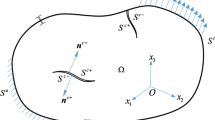Abstract
A boundary integral equation method (BIEM) is presented for 3D elastodynamic crack analysis. The method is based on a non-hypersingular BIE formulation, where the unknown quantities are the crack opening dispacements and their derivatives. The numerical scheme applied here uses a constant shape function for elements away from the crack front, and a “square-root” crack-tip shape function for elements near the crack front to describe the proper behavior of the unknown quantities at the crack front. A collocation method is applied to convert the non-hypersingular BIEs to a system of linear algebraic equations which are solved numerically. For several geometrical configurations, numerical results are presented for both the elastodynamic stress intensity factors and the scattering cross section. They are in good agreement with those obtained by other authors.
Similar content being viewed by others
References
Achenbach J. D. (1973): Wave Propagation in Elastic Solids. North-Holland, Amsterdam/New York
Achenbach J. D.; GautesenA. K.; McMakenH. (1982). Ray Methods for Waves in Elastic Solids. Pitman, Boston
Bonnet, M.; Bui, H. D. (1988): Regular B.I.E. for three-dimensional cracks in elastodynamics. In: Cruse, T. A. (ed.): Advanced Boundary Element Methods, pp. 41–47. Springer-Verlag
Budiansky B.; RiceJ. R. (1979): An integral equation for dynamic elastic response of an isolated 3D crack. Wave Motion 1, 187–192
Budreck D. E.; AchenbachJ. D. (1988): Scattering from three-dimensional planar cracks by the boundary integral equation method. J. Appl. Mech. 55, 405–412
Bui H. D. (1977): An integral equations method for solving the problem of a plane crack of arbitrary shape. J. Mech. Phys. Solids 25, 29–39
Chen, E. P.; Sih, G. C. (1972): Scattering waves about stationary and moving cracks. In: G. C. Sih (ed.): Elastodynamic Crack Problems, pp. 119–212. Noordhoff
Cruse T. A. (1988): Boundary Element Analysis in Computational Fracture Mechanics. Kluwer Academic Publishers, Boston, Mass.
Hirose S.; AchenbachJ. D. (1989): Time-domain boundary element analysis of elastic wave interaction with a crack. Int. J. Numer. Methods Engr. 28, 629–644
Irwin G. P. (1962): Crack-extension force for a part-through crack in a plate. J. Appl. Mech. 29, 651–654
Itou S. (1980): Dynamic stress concentration around a rectangular crack in an infinite elastic medium. Z. Angew. Math. Mech. 60, 317–322
Kitahara, M.; Nakagawa, K. (1985): Boundary integral equations in three dimensional elastodynamics. In: Boundary Elements VII, Springer-Verlag
Kobayashi S.; NishimuraN. (1982): Transient stress analysis of tunnels and cavities of arbitrary shape due to travelling waves. In: BanerjeeP. K.; ShawR. P. (eds.): Developments in Boundary Element Methods II, pp. 177–210. Applied Science Publishers, London
Krishnasamy G.; SchmerrL. W.; RudolphiT. J.; RizzoF. J. (1990): Hypersingular boundary integral equations: some applications in acoustic and elastic wave scattering. J. Appl. Mech. 57, 404–414
Le Van A.; RoyerJ. (1986): Integral equations for three dimensional problems. Int. J. Fract. 31, 125–142
Lin W.; KeerL. M. (1987): Scattering by a planar three-dimensional crack. J. Acoust. Soc. Am. 82, 1442–1448
Martin P. A.; Wickham G. R. (1983): Diffraction of elastic waves by a penny-shaped crack: analytical and numerical results. Proc. R. Soc. London. A390, 91–129
Martin P. A.; Rizzo F. J. (1989): On boundary integral equations for crack problems. Proc. R. Soc. London A421, 341–355
Nishimura, N.; Kobayashi, S. (1988): An improved boundary integral equation method for crack problems. In: Cruse, T. A. (ed.): Advanced Boundary Element Methods, pp. 279–286. Springer-Verlag
Nishimura N.; Kobayashi S. (1989): A regularized boundary integral equation method for elastodynamic crack problems. Comput. Mech. 4, 319–328
Okada H.; Rajiyah H.; AtluriS. N. (1988a): A novel displacement gradient boundary element method for elastic stress analysis with high accurary. J. Appl. Mech. 55, 786–794
Okada H.; Rajiyah H.; AtluriS. N. (1988b): Some recent developments in finite-strain elastoplasticity using the field-boundary element method. Computers & Structures 30, 275–288
Okada H.; Rajiyah H.; AtluriS. N. (1989): Non-hyper-singular integral-representations for velocity (displacement) gradients in elastic/plastic solids (small or finite deformations). Comput. Mech. 4, 165–175
Polch F. Z.; Cruse T. A.; Huang C.-J. (1987): Traction BIE solutions for flat cracks. Comput. Mech. 2, 253–267
Sládek V.; SládekJ. (1984): Transient elastodynamic three-dimensional problems in cracked bodies. Appl. Math. Modelling 8, 2–10
Takakuda K.; Koizumi T.; Shibuya T. (1985): On integral equation methods for crack problems. Bull. JSME. 28, 217–224
Weaver J. (1977): Three dimensional crack analysis. Int. J. Solids Struct. 13, 321–330
ZhangCh.; Achenbach J. D. (1989): A new boundary integral equation formulation for elastodynamic and elastostatic crack analysis. J. Appl. Mech. 56, 284–290
Zhang Ch. (1991): A novel derivation of non-hypersingular time-domain BIEs for transient elastodynamic crack analysis. Int. J. Solids Struct. 28, 267–281
Author information
Authors and Affiliations
Additional information
Communicated by S. N. Atluri, August 12, 1991
Rights and permissions
About this article
Cite this article
Zhang, C., Gross, D. 3D elastodynamic crack analysis by a non-hypersingular BIEM. Computational Mechanics 9, 137–152 (1992). https://doi.org/10.1007/BF00370068
Issue Date:
DOI: https://doi.org/10.1007/BF00370068




